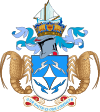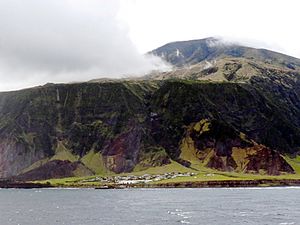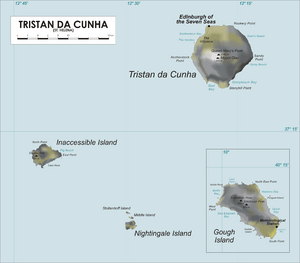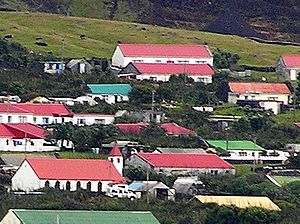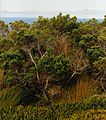Tristan da Cunha facts for kids
Quick facts for kids
Tristan da Cunha
|
|||
|---|---|---|---|
|
Overseas territory of the UK
|
|||
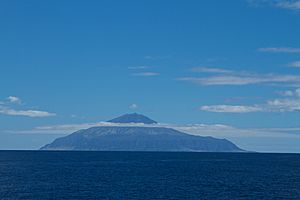
View from the ocean of Tristan da Cunha
|
|||
|
|||
| Motto(s):
"Our faith is our strength"
|
|||
| Anthem: God Save the Queen | |||
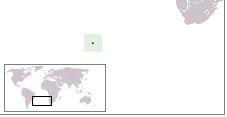
Location of Tristan da Cunha in the Atlantic Ocean.
|
|||
| Country | |||
| Overseas territory | Saint Helena, Ascension and Tristan da Cunha | ||
| Archipelago | Tristan da Cunha | ||
| Capital | Edinburgh of the Seven Seas | ||
| Discovered | 1506 | ||
| Current constitution | 2009 | ||
| Named for | Tristan da Cunha | ||
| Government | |||
| • Type | Monarchy | ||
| Area | |||
| • Total | 207 km2 (80 sq mi) | ||
| • Main island | 96 km2 (37 sq mi) | ||
| Highest elevation | 2,060 m (6,760 ft) | ||
| Lowest elevation | 0 m (0 ft) | ||
| Population
(2010)
|
|||
| • Total | 275 | ||
| • Density | 1.329/km2 (3.441/sq mi) | ||
| Demonym(s) | Tristanian | ||
| Time zone | UTC+0 (GMT) | ||
| Area code(s) | +290 | ||
| Internet TLD | none | ||
| Currency | Pound sterling (£) (GBP) | ||
| Website | http://www.tristandc.com/ | ||
Tristan da Cunha is a group of very remote volcanic islands in the southern Atlantic Ocean. It is known as the most isolated group of islands in the world where people live. The main island, also called Tristan da Cunha, is about 2,816 km (1,750 mi) away from South Africa, which is the closest land. It is even further from South America, at 3,360 km (2,088 mi).
The territory includes the main island of Tristan da Cunha, which is about 11.27 km (7.0 mi) wide and has an area of 96 km2 (37.1 sq mi). There are also other islands nearby that are not lived on, like the Nightingale Islands, Inaccessible Island, and Gough Island. These last two are special wildlife areas.
Tristan da Cunha is part of a larger British overseas territory called Saint Helena, Ascension and Tristan da Cunha. This territory also includes Saint Helena and Ascension Island, which are located further north. Only about 275 people live on Tristan da Cunha (based on 2009 numbers).
Contents
History of Tristan da Cunha
Early Discoveries and Landings
The islands were first seen in 1506 by a Portuguese explorer named Tristão da Cunha. He gave his name to the main island, but he couldn't land because the seas were too rough. Later, the name was shortened to Tristan da Cunha.
The first time anyone actually landed on the islands was in 1643. This was done by the crew of a Dutch ship called Heemstede. In 1656, the governor of Cape Town in South Africa thought about building a military base there, but the idea was dropped.
Other islands in the group were also discovered around this time. Inaccessible Island was found in 1506. Gough Island was also discovered by the Portuguese and later renamed by a British captain. The Nightingale Island was found by Dutch sailors in 1656 and later named by a British captain.
First Settlers and British Rule
The first person to live permanently on the islands was Jonathan Lambert from the United States. He arrived in December 1810 and even declared the islands his own property, calling them the Islands of Refreshment. However, he died just two years later.
In 1816, the United Kingdom officially took control of the islands. They ruled them from the Cape Colony in South Africa. This was done to stop the French from using the islands as a base to try and free Napoleon Bonaparte from his prison on Saint Helena. It also prevented the United States from using the islands during the War of 1812.
In 1867, Prince Alfred, who was the second son of Queen Victoria, visited the islands. The main town, Edinburgh of the Seven Seas, was named in his honour.
Modern History and Evacuation
In 1938, the Tristan da Cunha islands became a part of Saint Helena. Later, in 1981, the British government changed the status of these islands to "British Dependent Territories."
A big event happened in 1961 when the volcano on the main island, Queen Mary's Peak, erupted. This forced everyone living on the island to leave and go to England. The next year, a group called the Royal Society went to check the damage. They found that the main settlement, Edinburgh of the Seven Seas, was mostly okay. Because of this, most families were able to return home in 1963.
In 2009, Saint Helena and its two territories were given equal status under a new constitution. The British Overseas Territory was then renamed Saint Helena, Ascension and Tristan da Cunha.
Geography of Tristan da Cunha
The islands of Tristan da Cunha are actually the tops of volcanoes. These volcanoes are linked to the Mid-Atlantic Ridge, which is a huge underwater mountain range. The main island of Tristan da Cunha is the youngest, formed about 200,000 years ago. Nightingale Island is the oldest, at 12 million years old.
The name Tristan da Cunha refers to both the group of islands and the main island itself. The archipelago includes:
- Tristan da Cunha (the main island, about 96 km2 (37.1 sq mi))
- Inaccessible Island (about 14 km2 (5.4 sq mi))
- Nightingale Islands (about 3.4 km2 (1.3 sq mi) total)
- Nightingale Island (about 3.2 km2 (1.2 sq mi))
- Middle Island
- Stoltenhoff Island
- Gough Island (about 65 km2 (25.1 sq mi))
Inaccessible Island and the Nightingale Islands are located about 35 km (21.7 mi) southwest of the main island. Gough Island is much further away, about 395 km (245.4 mi) to the south-southeast.
The main island is very mountainous. The only flat area is where the capital, Edinburgh of the Seven Seas, is located on the northwest coast. The highest point is a volcano called Queen Mary's Peak, which is 2,060 m (6,759 ft) tall. It gets covered in snow during winter. The other islands in the group are not inhabited by people, except for a weather station on Gough Island. This station has been run by South Africa since 1956 and has a staff of six people.
Climate and Weather
The islands have a temperate and oceanic climate. This means the weather is mild and influenced by the ocean. The average temperature at sea level on Tristan is about 15 °C (59 °F). The temperature doesn't change much between day and night or between seasons. Gough Island is a bit colder.
It rains a lot on the islands. Tristan Settlement gets about 1700 mm of rain each year, and Gough Island gets even more, about 3300 mm. Strong winds are very common. The average wind speed is about 40 km/h. Winds get much stronger higher up on the mountains, and temperatures drop. So, while the lower areas have pleasant weather, the mountains can be snowy and very windy.
| Climate data for Edinburgh of the Seven Seas, Tristan da Cunha Island | |||||||||||||
|---|---|---|---|---|---|---|---|---|---|---|---|---|---|
| Month | Jan | Feb | Mar | Apr | May | Jun | Jul | Aug | Sep | Oct | Nov | Dec | Year |
| Mean daily maximum °C (°F) | 20 (68) |
20 (68) |
20 (68) |
19 (66) |
17 (63) |
15 (59) |
14 (57) |
14 (57) |
14 (57) |
15 (59) |
17 (63) |
18 (64) |
17 (62) |
| Mean daily minimum °C (°F) | 14 (57) |
14 (57) |
14 (57) |
13 (55) |
11 (52) |
10 (50) |
9 (48) |
8 (46) |
8 (46) |
9 (48) |
11 (52) |
12 (54) |
11 (52) |
| Average precipitation mm (inches) | 104 (4.1) |
92 (3.6) |
115 (4.5) |
140 (5.5) |
151 (5.9) |
156 (6.1) |
150 (5.9) |
160 (6.3) |
155 (6.1) |
142 (5.6) |
126 (5.0) |
125 (4.9) |
1,615 (63.6) |
| Source: Weatherbase.com [1] | |||||||||||||
The average yearly temperature in Edinburgh of the Seven Seas is about 13.9 °C (57.0 °F). February is usually the warmest month, with an average of 17.8 °C (64.0 °F). August is typically the coolest month, averaging 10.6 °C (51.0 °F).
The average amount of rain each year in Edinburgh of the Seven Seas is 1612.9 mm. August is the wettest month, with about 160 mm of rain. February is the driest month, with an average of 91.4 mm.
People and Population
The islands have a small population of about 275 people. The only place where people live is Edinburgh of the Seven Seas. Locally, it's often just called "The Settlement." The main religion on the island is Christianity, with people belonging to either the Anglican or Roman Catholic churches.
The people living on Tristan da Cunha today are thought to be descendants of 15 ancestors. These ancestors, eight men and seven women, arrived on the island at different times between 1816 and 1908. The men came from places like Scotland, England, the Netherlands, the United States, and Italy. They share only eight family names: Glass, Green, Hagan, Lavarello, Patterson, Repetto, Rogers, and Swain.
Gallery
-
A German ship in Tristan da Cunha. In the back is Queen Mary's Peak and to the right is Edinburgh of the Seven Seas.
Images for kids
-
Portuguese explorer and conquistador Tristão da Cunha is both the namesake of Tristan da Cunha and the first person to sight the island, in 1506.
-
Gough Island, Tristan da Cunha
-
Phylica arborea, the only tree species native (though not endemic) to Tristan da Cunha.
-
Sophora macnabiana (Fabaceae): coloured plate depicting the shrub in flower from Curtis's Botanical Magazine.
-
Sonchus asper a common introduced weed on Tristan.
-
Nesocichla eremita, the Tristan thrush.
-
The Inaccessible Island rail (Atlantisia rogersi) (1927), the world's smallest flightless bird, which is found only on Inaccessible Island
See also
 In Spanish: Tristán de Acuña para niños
In Spanish: Tristán de Acuña para niños



